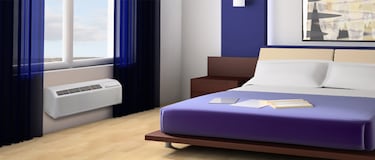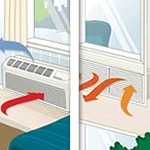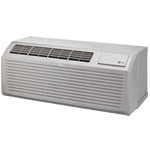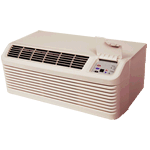
PTAC: Self Contained Air Conditioner Buyer's Guide
How to Pick the Perfect Packaged Terminal Air Conditioner
PTACs are all around us. You see them most often in hotels, hospitals, condos, apartments, college dorms, and assisted living centers. If you have a room that is hard to keep cool or warm, like a basement, sun-room, or addition, a PTAC unit may be just the thing you need.
A packaged terminal air conditioner (PTAC) is a compact, self-contained heating and air conditioning unit that will fit where traditional furnace and air conditioners won't, making them perfect for offices, workshops, or older buildings without ducts.
So whether you're outfitting a new motel or you're interested in supplemental air conditioning in an under-served area of your home, PTACs have you covered.
How Do PTAC Units Work?

PTAC units consist of a compressor, a heat exchanger coil, and a blower, all neatly contained within a single case. Because they're entirely self-contained, they're great for conditioning single rooms or small apartments where available space is everything.
Choosing the Right Heat Option

A heat pump brings in concentrated heat from outside air. Heat pumps are more efficient, but are typically only found in warmer climates because they don't operate as well once outside temperatures drop below 40 degrees F. Select units may operate in temperatures below 40, but efficiency generally decreases with the temperature.
Units with electric heaters pass air over a heating element that's warmed by an electric current. The warmed air is then dispersed throughout the room by a strong fan. These units are ideal for cooler climates because they don't rely on heat from outdoor air.
Choosing the Right Size

If you choose a unit that has too high of a BTU capacity, it won't remove humidity from the air effectively enough, leaving the room damp. A higher BTU capacity can also wear out the unit by cycling on and off too frequently.
To make sure you are getting the right size PTAC, don't just rely on simple square footage estimates. There are many other factors that can have a large impact on the BTUs needed to heat and cool your room.
Instead, use our PTAC sizing tool below to get an estimated BTU range for your space. This tool was created by our engineers as a simplified "Manual J", the advanced calculation used by professionals to determine exact heating and cooling loads.
Build Your Own Mini Split System
